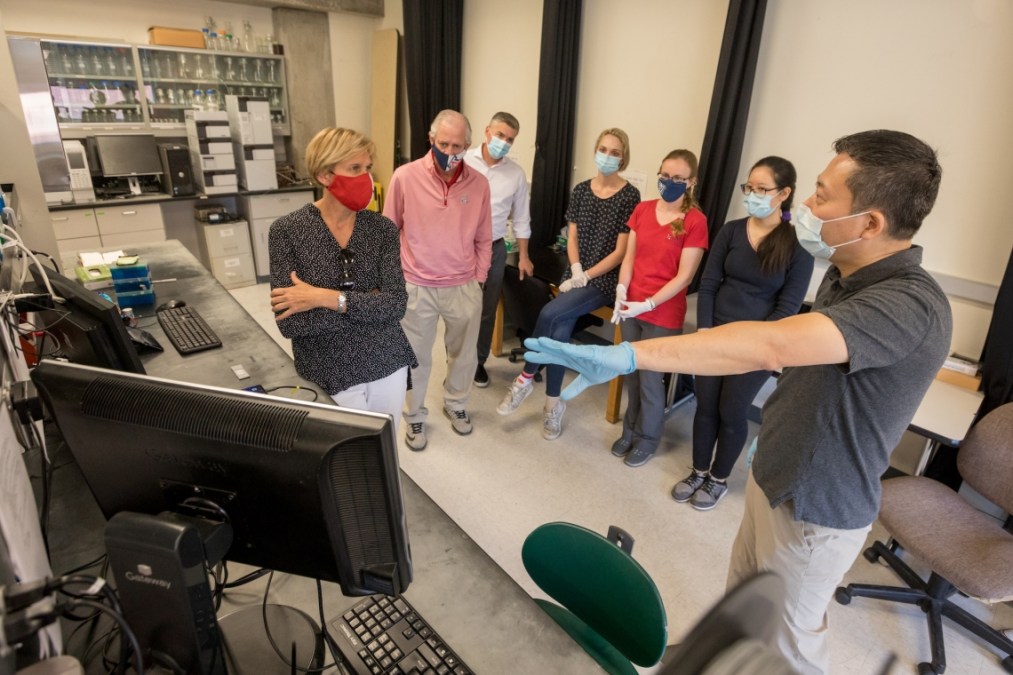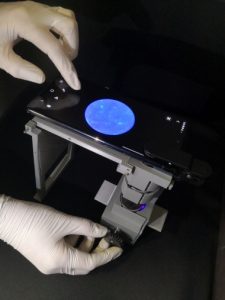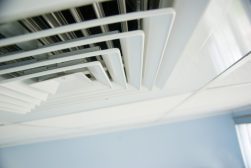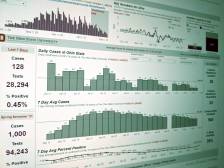U. Arizona is developing smartphone-based COVID-19 tests

Painful nose swab no more — researchers at the University of Arizona have announced they’re developing a smartphone-based COVID-19 test that’s simple enough it can be conducted by non-scientists.
The test relies on a smartphone-connected microscope to analyze saliva samples and can deliver results in just 10 minutes, the university announced last week. The test requires only a smartphone, a simple microscope and a piece of medical-grade, wax-coated paper. According to the university, the materials needed for a single test cost about $45.

The smartphone-based test. (University of Arizona)
The test involves introducing fluorescent COVID-19 antibodies to a potentially contaminated sample; if virus is present, the tester will see the antibodies attached to the sample in a photo taken with the microscope and smartphone. The process is simple enough that non-scientists can learn it by watching a video, according to the university.
Once the research is approved by the university’s institutional review board, testing facilities on campus will be able to use the method if the students being tested provide written consent. The researchers envision the distribution of the devices throughout campus so that the “average person” can conduct tests.
Using a method originally developed to detect norovirus, researchers are aiming to combine the speed of a nasal swab antigen test with the accuracy of a nasal swab polymerase chain reaction, or PCR, test. The saliva component of the test comes from a saline gargle COVID-19 test developed by Michael Worobey, head of the university’s biology department.
‘Make your own device’
The research is headed by Jeong-Yeol Yoon, a professor of biosystems engineering who leads a team of undergraduate and graduate students. Researchers said they hope their research, which was published in the biology journal Nature Protocols last week, will be replicated and expanded by others.
“We’ve outlined it so that other scientists can basically repeat what we did and create a norovirus-detecting device,” Lane Breshears, a doctoral student co-developing the test, said in a press release. “Our goal is that if you want to adapt it for something else, like we’ve adapted it for COVID-19, that you have all of the ingredients you need to basically make your own device.”
The method is intended, researchers said, to bridge competing testing methods that each have their own flaws.
“I have a couple of friends who had COVID-19 that were super frustrated because their PCR results were taking six or seven days or they were getting false negatives from rapid antigen tests. But when they got the final PCR tests, they found out they had been sick, like they’d suspected,” Katie Sosnowski, a doctoral student at the lab, said in the press release. “It’s really cool to be working on a detection platform that can get fast results that are also accurate.”
Losing the microscope
Yoon’s team is also working on making testing even easier by eliminating the need for a microscope. Using only an AI-powered smartphone app, a microfluidic chip and a QR code, researchers believe people could one day test themselves.
“Unlike the fluorescent microscope technique where you get the chip into just the right position, you just take a snapshot of the chip,” one student explained in the university announcement. “No matter the angle or distance the photo is taken from, the smartphone app and use AI and the QR code to account for variances and run calculations accordingly.”
This method, however, comes with an additional room for error, the researchers said.
The research to develop quicker and cheaper COVID-19 testing builds on the University of Arizona’s pandemic efforts over the past 10 months. In September, the university began testing sewage to find asymptomatic COVID-19 cases. The university also reported in December that its contact tracing app reduced the spread of coronavirus by 12%. And last month, as vaccinations became available, the university launched a website with information on the process.




